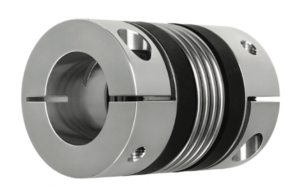
For the past 30 years or more, designers of highly dynamic servo drive systems have been turning to bellows couplings to optimize the stiffness, inertia, and smoothness of rotation in their coupling applications. When it comes to torsionally rigid couplings the stainless steel bellows wins in all three categories. Take for example high-speed camming of large inertia rollers in the paper and film products industries.
As machine cycle rates continue to increase, the higher stiffness of the bellows becomes a necessity in cases where flexible disc couplings have been known to fail from extreme dynamics. A bellows coupling with aluminum hubs also offers the lowest inertia, doing its part to reduce strain on the motor and allowing it to be more responsive. In other instances, the symmetry of the round bellows helps to improve the smoothness of output rotation, minimizing mechanical noise in highly sensitive test systems, and making for sharper images in servo-driven printing presses. When shaft alignment is controlled, and production planning in place, bellows couplings are a proven winner in modern high-speed and high-precision equipment. Then why use servo disc couplings?
While the bellows coupling may offer the ultimate in precision performance, the servo disc coupling can be a close second in that regard and can offer some other advantages, especially in terms of easier handling. For just those situations, R+W is pleased to introduce its new SCLseries of flexible disc couplings for servo drive applications.
One advantage of the dual disc servo coupling is greater flexibility, specifically in terms of lateral offset between shafts. Depending on the size they can tolerate anywhere from 50-100% more misalignment than the corresponding bellows coupling, albeit at a decrease of 30-50% of torsional stiffness. In precision applications where shaft alignment is more difficult to control, and extreme torsional stiffness is not needed, servo disc couplings might be the right choice — especially if there is no piloted interface between the motor and the driven shaft journal.
A precision coupling sheared from misalignment can make for a costly and unpleasant situation, especially in a high-speed production environment. While this can happen with either coupling style when excessively misaligned, the disc coupling is more tolerant of shaft offsets, reducing that probability where greater misalignment exists.
A second advantage of using servo disc couplings is their tolerance for harsh chemicals and higher temperatures. Since the coupling is made of all positive locking connections, the possibility of certain machine tool coolants, cleaning agents, etc. breaking down the internal connections is reduced. By contrast, bellows couplings up to a certain size are normally bonded together with high-strength bearing retaining compound. This allows for the bellows-hub connection to be floated, free of bending stress, until the bonding agent cures, while the hub bores are held concentric to one another on a common arbor. This works well in most applications, but the bond can be broken down by certain chemicals. That can be addressed by making the bellows coupling with welded steel hub connections, instead of the standard bonded aluminum. While this makes them more corrosion resistant and still offers the advantages of greater torsional stiffness and symmetry, it also shifts the weight, moment of inertia and cost advantages to disc couplings where aggressive chemicals are present.
Finally, disc couplings offer some modularity, which allows for relatively fast assembly without the need for proprietary techniques. This makes it possible, with the help of a few extra tools, to stock the individual hubs in a variety of bore diameters and assemble them as needed. Furthermore, if it is critical for your company to have off-the-shelf availability of the coupling, it can be more convenient to set things up to eliminate lead times through assembly rather than machining.
By contrast, bellows couplings normally have a small lead time associated with them, or otherwise need to be stocked as assemblies with minimum bore diameters and machined as needed once the required bore diameters have been determined. If off the shelf availability is critical, disc couplings can allow users to set themselves up to virtually eliminate lead times.
In conclusion, while for many designers of high-speed and high-precision equipment the bellows coupling is a no brainer, there are some situations where it can be less convenient to accommodate. Engineers should always consider the costs of overcoming obstacles that may stand in the way of optimizing coupling performance, and ensure they are not overreaching. Sometimes simpler is better.

Leave a Reply